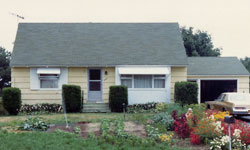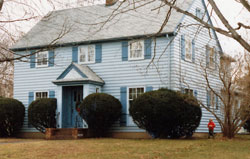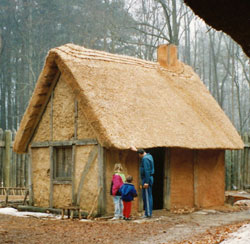Our large house
 ©Janet Allen
©Janet AllenOur first house, a Cape Cod
Our first house was a Cape Cod in a development of homes built in the early 1950s, and many of the original families still lived in these homes, having raised large families in these small homes.
After a while though, we Baby Boomers decided that, after our daughter was born, that this house couldn't possibly be big enough or nice enough. We bought a larger house a few miles away.
 ©Janet Allen
©Janet Allen Our house as it looked about 25 or 30 years ago when we first moved in
Our "new" house was a typical colonial built in the early 1940s, probably the last era of truly well-built houses, unlike most houses in most newer developments.
Compared to our previous house, this house at first seemed very large. After a few years, we added a son and with two older children, and it began to seem not quite as large. But it actually was a problem of not enough of the right kind of space. We wanted a place for the kids to play within sight of the kitchen, and we wanted access to the back yard.
 ©Janet Allen
©Janet AllenOur house now
In fact, being a corner house, the kitchen looks out onto the small space between our house and our neighbor's, rather than onto the back yard, so it wasn't possible to see the kids when they were playing outdoors.
We added a family room (actually converting the garage and building another garage), partly because we wanted some more space, but also because our garage, placed between our kitchen and our backyard, prevented us from enjoying our backyard.
With this added room, we have seldom used the living room or even the dining room, so we have a lot of unused, wasted space—in fact, except for the kitchen, most of the original house.
We since have added an office area, stolen from our added garage, adjacent to the backyard.
 ©Janet Allen
©Janet Allen We especially enjoy our pond and stream
At about 2,000 sq. ft., it probably doesn't qualify as a large house by today's standards, but it's still too large to be a model of sustainability.
Now, with our empty nest, it is obviously too large for just the two of us. We could easily live on just the main floor. Then why do we stay?
First, because we put a lot of effort into the house and wouldn't want to start over redecorating etc. We also always repaired and upgraded with quality materials. We also thoroughly insulated it and implemented all sorts of other energy conservation efforts. We know the house is solid and doesn't have any problems. We just don't want to start over.
More important, though, is that we've put so much of ourselves into our yard—and we have such good soil—that it would be hard to leave.
A more sustainable alternative?
 ©Janet Allen
©Janet AllenA house in Jamestown
When the kids were little, we visited the early settlement in Jamestown, VA. Here's one of the houses that foretold our son's interest in cob building.
When we think about smaller, sustainable houses, many people react negatively, thinking it represents a lower standard of living.
This is a good example of the behavioral economics concept of "loss aversion." For example, studies with monkeys show that a monkey with one apple is content, but when someone takes one apple away from a monkey who has two apples, leaving him with one, he is not happy. In other words, it's not the amount we have, it's a change in the amount. Years ago, people with a "small" home were happy, but if we were to suggest to people currently living in today's typically larger house that they now move to the same small house, they wouldn't be happy.
BUT as with other aspects of sustainable living, we don't have to return to to the past! Modern versions of smaller homes incorporate not only newer understandings of how to build such homes, but also incorporate reasonable conveniences of modern life. They can create even higher quality of life in many ways.
